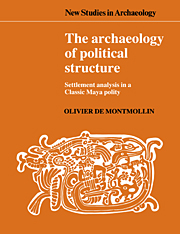Book contents
- Frontmatter
- Contents
- List of figures
- List of tables
- Preface
- 1 Studying ancient complex polities
- 2 Thinking about Maya political structure
- 3 The Rosario polity
- 4 Linking Maya politics and settlement
- 5 Centralization
- 6 Differentiation and integration
- 7 Political regimes and microcosms
- 8 Political stratification patterns
- 9 Mechanical versus organic solidarity
- 10 Segmenting versus non-segmenting organization
- 11 Archaeological study of Maya polities
- Notes
- References
- Index
10 - Segmenting versus non-segmenting organization
Published online by Cambridge University Press: 29 March 2010
- Frontmatter
- Contents
- List of figures
- List of tables
- Preface
- 1 Studying ancient complex polities
- 2 Thinking about Maya political structure
- 3 The Rosario polity
- 4 Linking Maya politics and settlement
- 5 Centralization
- 6 Differentiation and integration
- 7 Political regimes and microcosms
- 8 Political stratification patterns
- 9 Mechanical versus organic solidarity
- 10 Segmenting versus non-segmenting organization
- 11 Archaeological study of Maya polities
- Notes
- References
- Index
Summary
Social statics and dynamics
The tendency of polities to segment or cohere is an aspect of political organization (dynamics). At the segmenting end of a continuum, polities show a tendency to break apart into constituent districts, while at the non-segmenting end, polities are less prone to break apart, maintaining their cohesiveness over long(er) periods (Chapter 2). It is particularly difficult to determine where the Rosario polity fits along this continuum, and to answer the fifth research question concerning the tendency of Maya polities to segment. In working around the edges of the problem, I examine several themes (listed in decreasing order of generality): structure (social statics) versus organization (social dynamics) and how one moves from the former to the latter, inferring diachronic (possibly cyclical) developments from synchronic evidence, and the relation of the Rosario polity's breakdown to the Classic Maya Collapse.
To reiterate an earlier point (Chapter 2), I draw a distinction between organization and structure. Structure (social statics) consists of relatively enduring and abstract norms, principles, or institutions for arranging and regulating relations among societal actors. Organization (social dynamics) is a contingent situational set of activities and pragmatic behaviors on the part of societal actors (after Firth 1964). My prior analysis has concentrated on structure (Chapters 5–9), with a problem orientation tailored closely to the chronological possibilities and limitations of settlement data (Chapter 4). A climax-crash view of settlement development allowed interpretation of patterns detectable from single-period settlement maps, according to principles of political structure. To get at questions of organization with such material is exceedingly more difficult.
- Type
- Chapter
- Information
- The Archaeology of Political StructureSettlement Analysis in a Classic Maya Polity, pp. 206 - 216Publisher: Cambridge University PressPrint publication year: 1989



